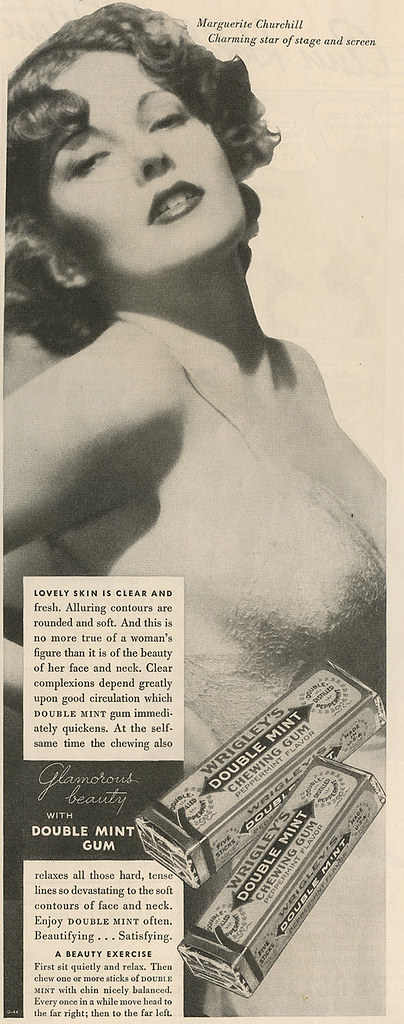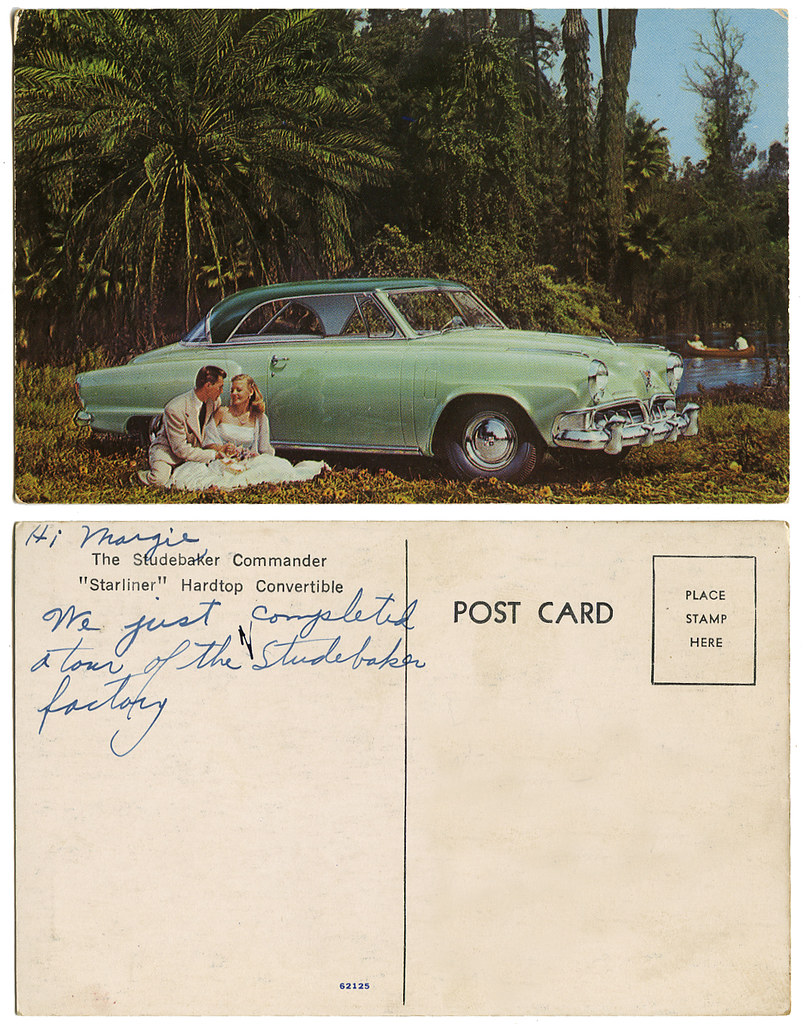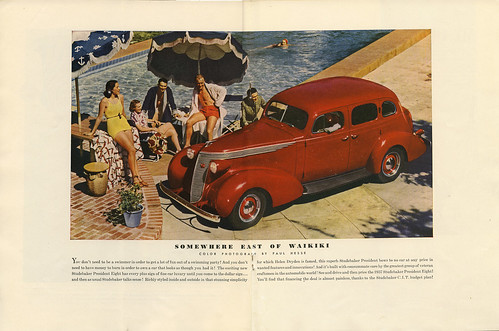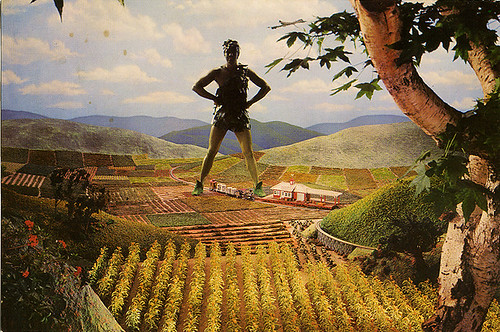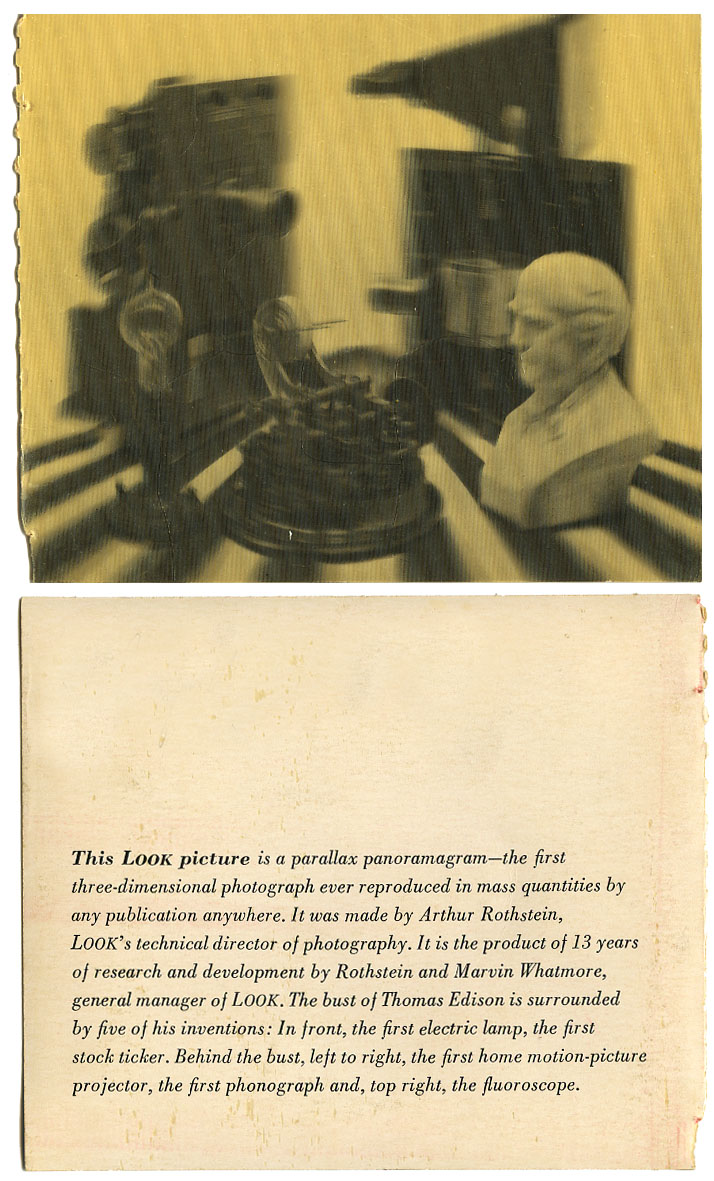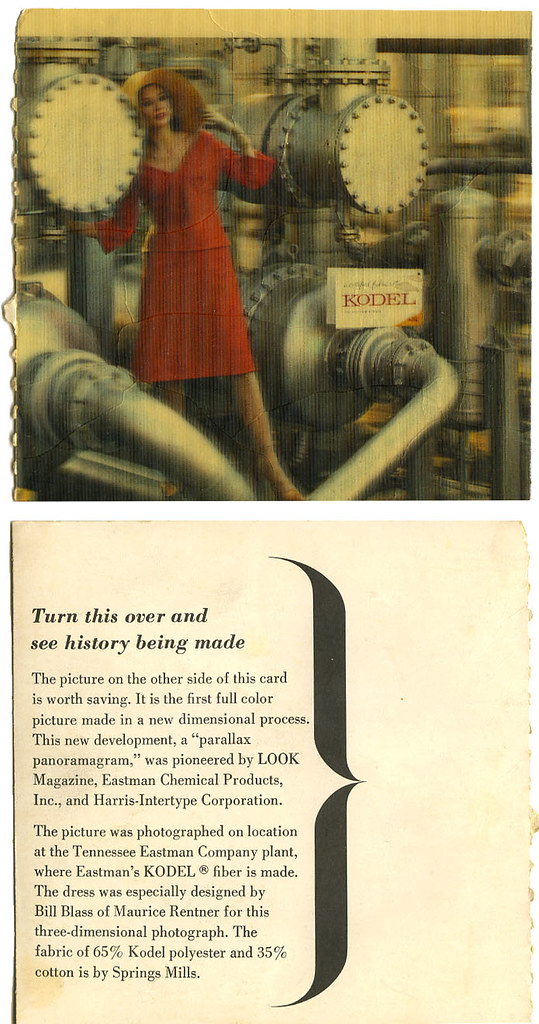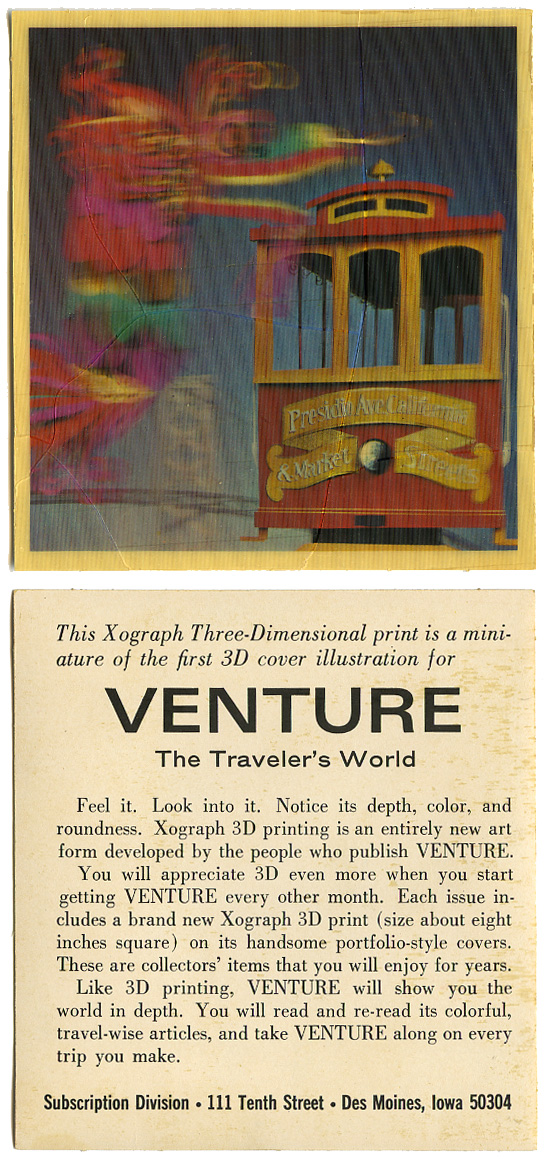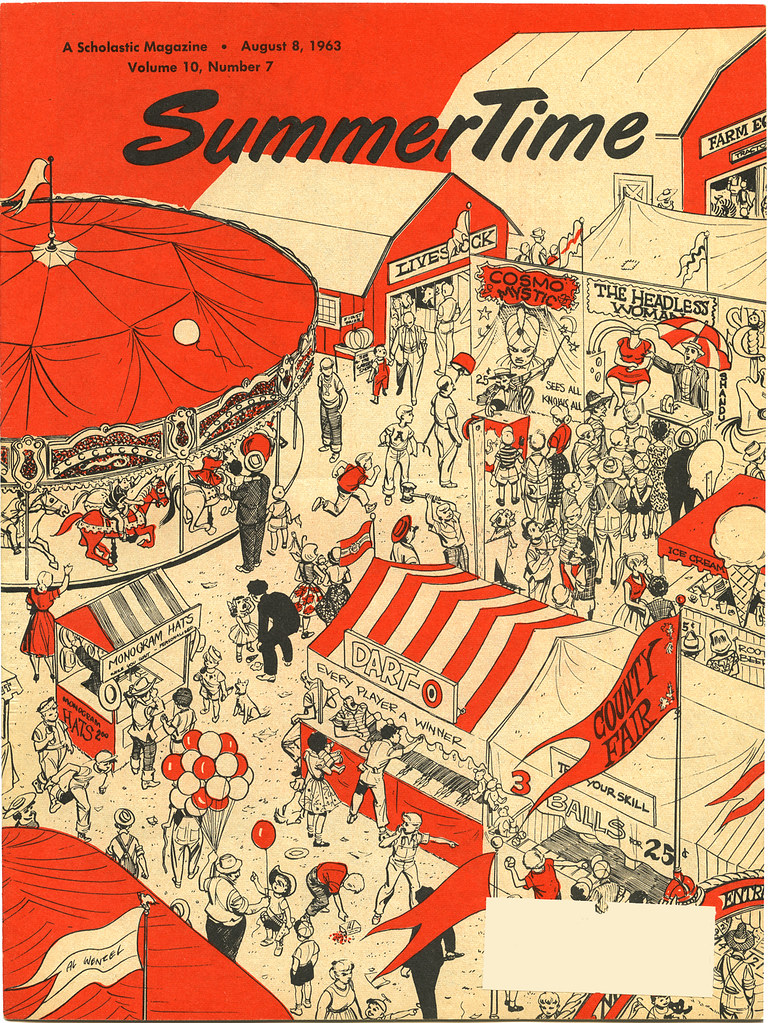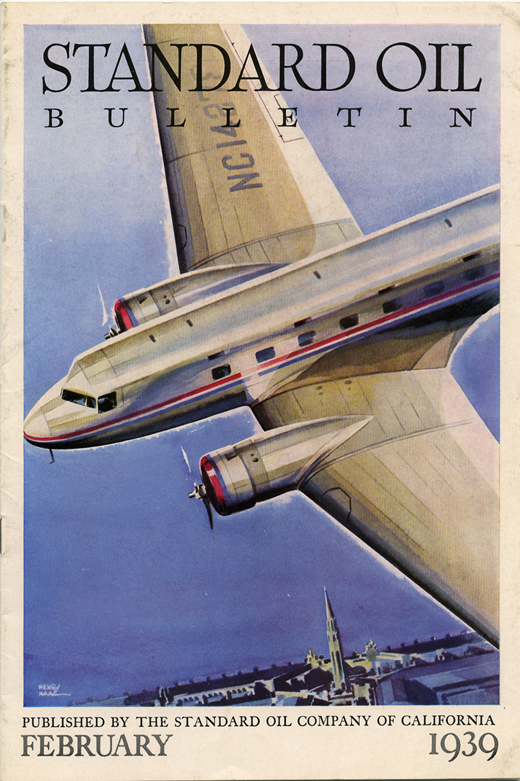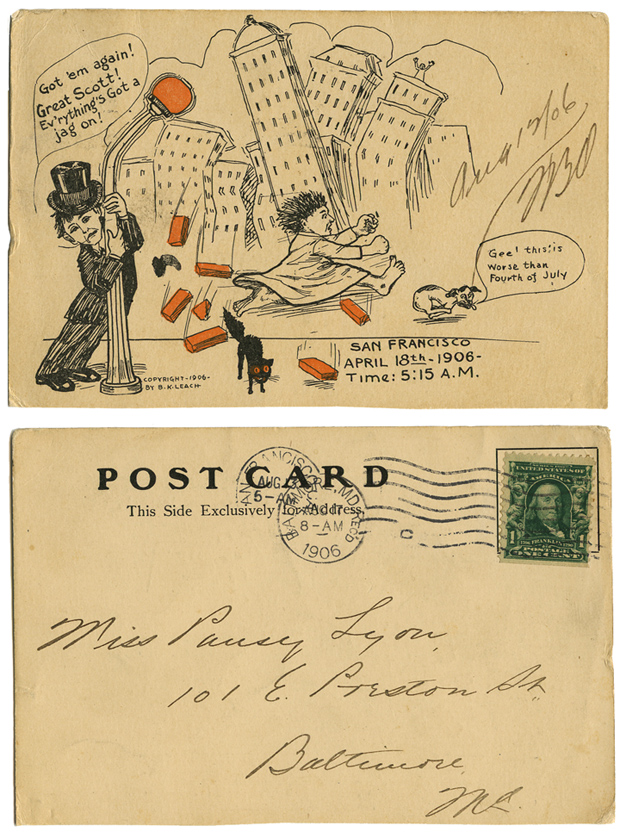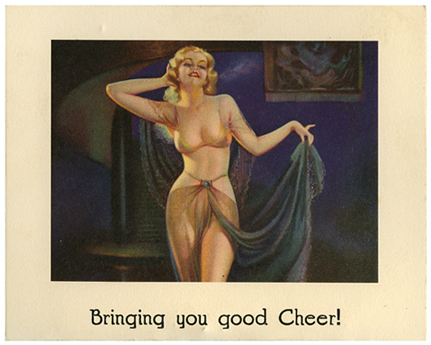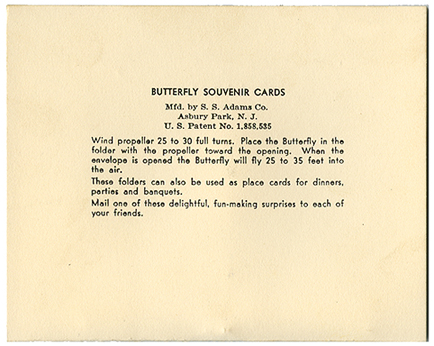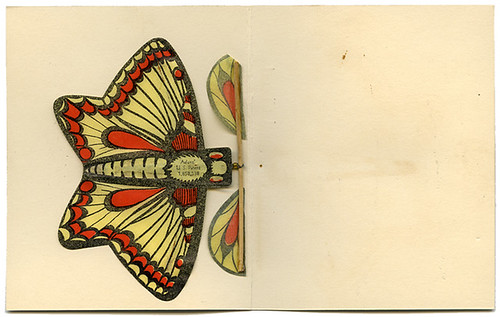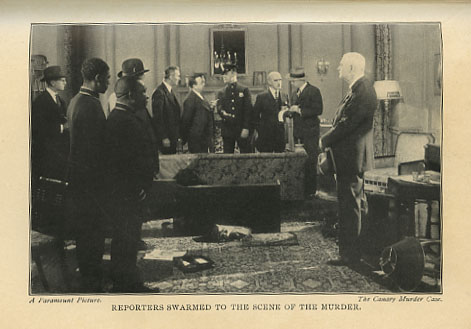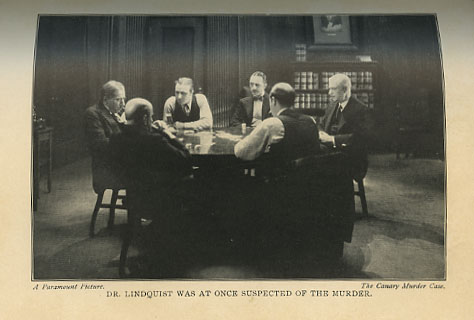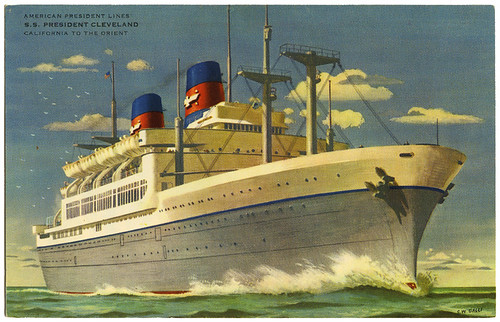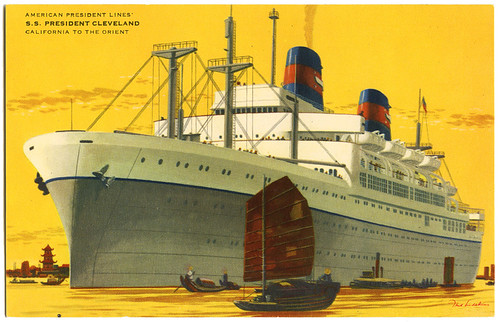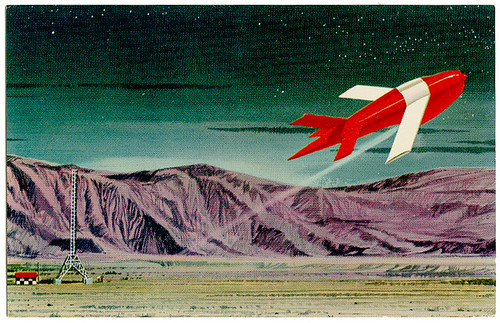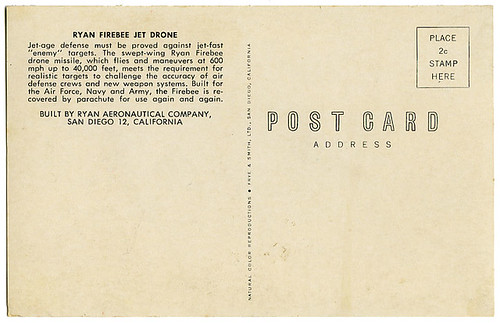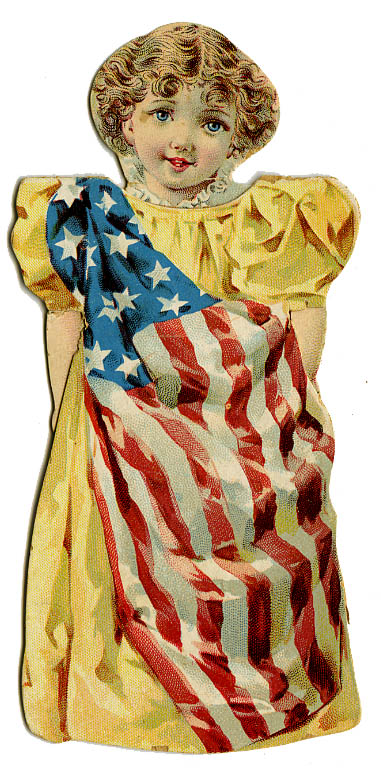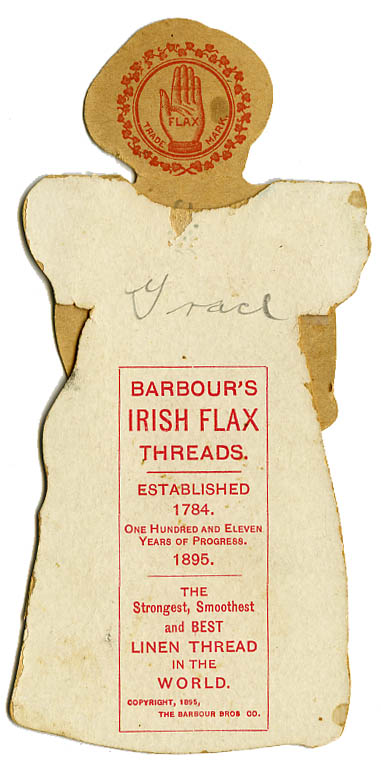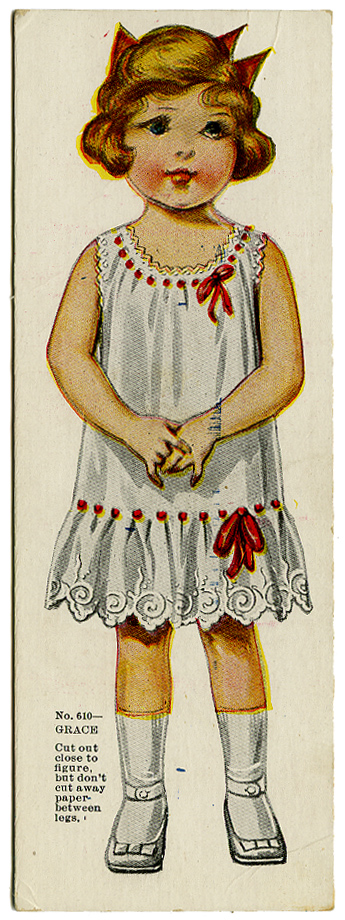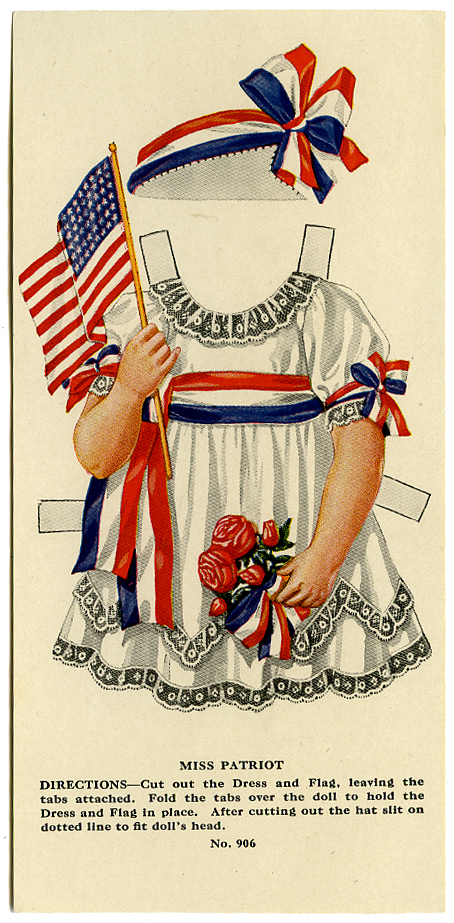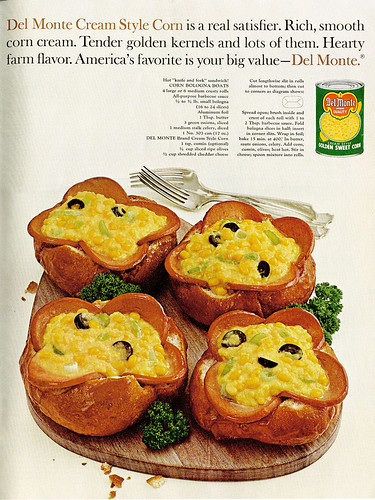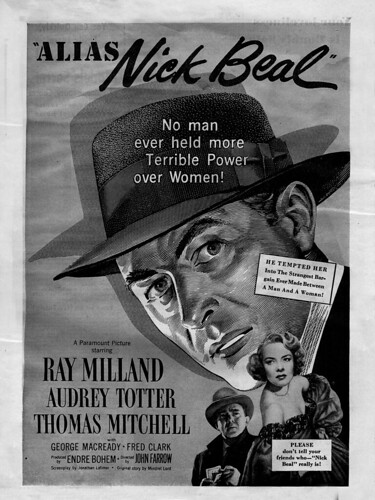1939The Doublemint Twins concept makes its advertising debut. Since then, the Doublemint twins have been part of one of the most successful and long lasting advertising campaigns ever created. In the early days of the campaign, one Wrigley-sponsored radio program featured double piano players, double violinists and double talking comedians.
7/31/09
THE DOUBLE MINT TWINS of 1934
7/30/09
STUDEBAKER?
7/29/09
Wouldn't you like to own a STUDEBAKER?
"I don't believe that it is just plain 'orneriness' that makes us act as we do when driving. Certainly I don't believe that we are all sadists at heart, getting a big kick out of offending, scaring and even injuring other people.I prefer to believe that our tendency towards bad motor manners is merely part of the huge comedy that makes us human beings--and makes us careless and selfish....Sometimes you hear the remark, too, that people are just too dumb and slow-witted to learn how to operate anything which responds as quickly as the modern automobile. It is argued that people can walk without continually bumping into others, because of the thousands of years of practice they have had since their ancestors came down from the trees; but that it will take us hundreds of years at least to learn how to deport ourselves as instinctively orderly drivers.Yet, it has been my observation that few drivers really deserve a dunce cap. Rather, most accidents are the result of mere thoughtlessness on the part of driver and pedestrian. All of us have numerous friends who have driven five--ten--fifteen years or more with never an accident or at least never a serious accident. Those who have had accidents may be inclined to cal these clean records the result of better luck; but undoubtedly, if we check into the driving habits of people who had had no accidents, or very few accidents; and then check the minority--those who have had a series of accidents--we shall find important difference in driving habits."
7/25/09
GREEN with envy
Something a little special today for the blog. I've managed to bag an interview with one of America's big icons. A lot of negotiations took place with agents, company reps, etc. along with a binding contract that I not give the exact location where the interview took place. I'm more than happy to give this giant in the industry his privacy.
First a little background information. Jolly Green grew up in Minnesota, making his first appearance in 1928, the year before the Great Depression. He came from modest means, a happy family, but frankly, he wasn't real popular. He was sent to charm school in the 1930s and gradually over the years developed into the charming fellow we all love.
Click on either image to see it larger.
I CAN say that this interview took place while he was on vacation in California along the North Coast amongst the redwood groves.
Tattered and Lost: Mr. Green...
Jolly Green Giant: Call me JG.
T & L: Okay, JG. What brings you here to the forests of the North Coast?
JG: Well, as you can imagine it's hard for me to just get away, be myself. I don't tend to blend in and if I go to the beach that's pretty much it for anybody else who was planning to go for the day. By the time I've thrown down a beach towel and stretched out the tide usually goes out. I try to find places now where I can spend some quiet time. I can walk through this forest and actually feel small. I don't get that very often.
T & L: I understand completely. Well, actually I have no reference point for this, but I can imagine.
JG: I feel I have certain responsibilities to my fans, the "little people" and I don't want to disappoint any of them. My folks didn't name me Jolly for nothin'. (laughing)
T & L: I was going to ask you about that. Is it tough always having to be so upbeat?
JG: Oh no, not at all. (laughing) What have I got to worry about? I can see things coming from miles away so I'm always prepared. That's how I've tried to live my life. Look off into the distance and be ready for anything. Keep a positive attitude.
T & L: Can I ask you a little about work?
JG: Sure.
T & L: Well, you've done a lot of television spots over the years. Where were they filmed?
JG: Oh we film those in Minnesota, in the valley where I was born and raised. Beautiful place, simply beautiful. Have you been there?
T & L: No, I'm sorry to say I haven't.
JG: Oh you must. Do you like vegetables?
T & L: Of course.
JG: Then you'll like the valley. Hard working little people producing some great products.
T & L: Well, that brings up a subject that gets talked about a lot.
JG: Oh, I know where this is going.
T & L: You do?
JG: Sure. You want to know about my niblets. Right?
T & L: Actually yes, we're all sort of curious about them.
JG: I'm proud of my niblets. You won't find finer niblets on the shelf. Quite a package if I do say so myself.
T & L: Was there ever any concern about calling them niblets?
JG: No, not really. We thought of trying kernel but it had different meanings in different parts of the country depending on how people spelled it so we decided to stay with niblets. What can I say (laughing), people just LOVE my niblets.
T & L: I can imagine with your size there are some funny stories to tell about filming. Anything really wild ever happen?
JG: Oh, all sorts of wild stuff, but usually only if they bring in a crew from out of the area. The locals all know me and we all work together as a tight unit. Time is money, so we get into the valley and out, usually in two days. I like to be a one take guy if at all possible. Usually the hardest part is waiting for the lighting to be just right. You know, magic hour.
T & L: This might be a bit personal, but because of your size has anything unfortunate ever occurred?
JG: Really, only the one time and I'm not sure people are aware of this so I guess I'm giving you an exclusive.
T & L: Wow, let's here it.
JG: (laughing) Now this happened many years ago and since then we've implemented a variety of safety procedures to make sure it doesn't ever happen again. You know how sometimes when you sneeze you just sort of loose control? An arm or a leg might...well...sort of flail around?
T & L: Oh no.
JG: (nodding) Yup, I spun around trying to not sneeze on the crew in the valley, started to loose my footing and BAM! my left foot came down on the train station. Completely flattened it. Fortunately nobody was in it at the time. The problem came the next day when the director realized we needed to do some re-shoots at the station. I mean, my crew is good, but they can't reconstruct the station overnight. So a friend of a friend called Lionel Trains and they brought in a modular station the next day. Had it up in place within no time. It just snapped together. If you look real close in the commercial you can see it's different, but the people in the valley used that station for a good six months while the insurance people did their thing. Eventually a check was cut and the station was replaced and looks just like the original.
T & L: Well, I'm thrilled for the exclusive and equally thrilled to hear it had a happy ending.
JG: Me too. Me too. Size can be a burden.
T & L: Speaking of endings, I guess I better wind this up.
JG: Oh, is it over already? I was just getting into the groove of this.
T & L: This has been really, and I can't say it enough, a big thrill to meet you.
JG: I hope I didn't let you down.
T & L: Oh, no, not in the least. But speaking of which...
JG: (laughing) I guess you want out of the tree, don't you?
T & L: Uhhh, yes please.
JG: How was it up there?
T & L: Great actually. I'm glad you thought of it. It was much easier doing this interview being able to look you in the eye instead of standing down at your big toe yelling up.
JG: Like I said, I'm always trying to be prepared, think ahead. It's all in how you look at things.
7/24/09
Living in a PARALLAX PANORAMAGRAM UNIVERSE
Parallax panoramagram having improved depth and sharpnessUnited States Patent 6850210Abstract: A parallax panoramagram has increased depth and sharpness when a sharpness filter is applied after interdigitation of multiple image portions. An optical path of wave train (204) (on-axis) and wave train (205) (off-axis) intersect a single lenticle (201). The lenticle has a focal length (208) and the on-axis (204) and off-axis (205) wave trains correspond to different stripes. These wave trains (204 and 205) comme to focus at points (206 and 207) respectively. The surface (202) has a cylindrical curvature, and bracket (203) denotes the width of the lenticle (201). Each eye of the observer sees its own perspective view when looking at a lenticular stereogram. (SOURCE: http://www.freepatentsonline.com/6850210.html)
"A LOOK FIRST: 3-D PHOTO," proclaimed the message on the cover. The Parallax Panoramagram "may mark the beginning of a new era in graphic-arts," said the press release. As it turned out, Look's first ran almost last in the magazine. On page 105, just short of the back cover, persevering readers found a stiff, postcard-size appendage, attached in the manner of a subscription renewal card. On the card was a black and white picture that showed a bust of Thomas Alva Edison surround ed by some half-dozen of his inventions. What made most readers stop and look twice was the picture's distinct illusion of depth.Look's stunt, the result of 13 years' research, constitutes the latest effort to translate the real world of three dimensions into the picture world of two. Artists have employed trompe I'oeil three-dimensional techniques for centuries. But true success for photographers awaited the invention of the stereopticon camera in the 19th century, which took two pictures of the same subject through lenses that were separated like a pair of human eyes. When the viewer saw each picture separately, through separate lenses, his brain automatically supplied the missing dimension of depth.The Look process is almost identical. A specially designed camera takes pictures through a transparent screen that is serrated to break up the image into hair-thin vertical slices. The camera is then moved slightly to the right or left, as other, sliced-up pictures are taken on the same negative.The process is laborious, costly and slow, and not yet adaptable to highspeed printing. Merely to pose the static picture in last week's Look took two full days of work with a one-ton, cubical camera as complicated as an electronic computer. Five additional weeks were required to engrave the photograph, print it some 7,000,000 times on a sheet-fed offset press and then pour on and properly shape the clear plastic film that covers the picture with what amounts to a collection of lenses. The plastic lenses are so arranged that the viewer's left eye sees one of the serrated pictures, the right eye sees the other (see diagram).Look and its partners in the enterprise, Eastman Kodak Co. and Harris-Intertype Corp., which built the equipment that adds the plastic lens coat, have high hopes of commercial success. Cowles Magazines & Broadcasting, Inc., Look's parent company, plans to establish a separate corporation, to be called Visual Panographics Inc., to sell its 3-D process to greeting-card manufacturers, display-art companies and anyone else willing to pay the price in money and time for an unspectacled illusion of depth. (SOURCE: TIME)
three-dimensional printing technique ( in printing (publishing): Three-dimensional printing (1960s) )...essentially an illustration bearing two views, superimposed, of the same image taken from slightly different angles, on a transparent mount striped with a multitude of imperceptible parallel strips (Xograph process). On account of these strips, each eye, looking at the print from a different angle, sees only one image. (SOURCE: ENCYCLOPÆDIA BRITANNICA)
UPDATE: From Debbie Thorne in 2013:"Lenticular techniques showed rapid progress in the 1960's as large corporations recognized its advertising potential. Mass production became a reality on February 15, 1964, when a Look Magazine issue featured the first ink-printed postcard sized "parallax panoramagram". The black and white still life of the bust of Thomas Edison surrounded by some of his more famous inventions required a 1000-pound camera, tracked in a programmed arc, to photograph. The manufacturing process involved printing the image using a 300 line offset press and a special technique for coating and lenticulating a thin layer of plastic on the image at high speed. The process, known as "Xograph" was developed at Eastman Kodak in Tennessee and was credited to Arthur Rothstein and Marvin Whatmore. Over 8 million copies were sold. Look Magazine followed with a color lenticular on April 7, 1964.With the growth in popularity of lenticular in the 1960's, several companies entered the market including Vari-Vue of New York, which was co-founded by Victor Anderson, who contributed greatly to the practical commercial success of the product. Vari-Vue, along with companies such as Crowle Communicatons, Hallmark, Toppan ("Top Stereo") and Dai-Nippon of Japan and later Optigraphics ("Optipan" and "Linearoptics") produced a wide variety of products over the next twenty years, including Cracker Jack premiums, Political buttons, 3D baseball cards, postcards, magazine and book covers and point-of-purchase displays.By the 1980's, as the novelty value of lenticular wore thin, the only significant manufacturer left in the US was Optigraphics who's success was largely the result of the continued expertise of Victor Anderson."
I found your site when trying to do something special with all my fathers negatives, black and white photos and slides that he has collected from his travels as a photographer for Look and Venture magazines. i was excited to see his 3 d photos on your site. Our family has albums of the 3 d pictures. I also watched my dad shoot many 3d pictures at the look magazine building on madison ave in nyc. Then the studio in Arlington, texas. He would create a shadow box for some pictures where he would cut out the models or items they were advertising. The camera was very large and it would move slowly to shoot a blurred image and then my father would design a plastic coating to give the photo the 3d effect. I have a very large mac tonight picture he did for Mc donalds hamburger in the late 60's or early 70' My fathers boss and a friend was Arthur Rothstein. They worked for look and venture until spring of 1973. Victor Anderson was one of the men at opticgraphics.
7/23/09
AL WENZEL
From reader Brian:Albert Borth Wenzel was educated at the Grand Central School of Art. He began his career in comics in the late 1940s by contributing to comic books by D.S. Publishing and Lev Gleason (a.o. Crime Does Not Pay, Little Wise Guys). He did romance stories for Marvel, fillers for DC and some horror work for ACG in the 1950s. He was an assistant on the syndicated 'The Spirit' (1951-52) and 'Steve Roper' (1957-59) strips.
He became Roy Crane's assistant on the 'Buz Sawyer' Sunday in 1960 and by 1962, he did scripts, pencils and ink. He continued to work on this strip, telling the urban adventures of Sawyer's sidekick 'Roscoe Sweeney', until 1974. In the late 1970s and early 1980s, he illustrated some giveaway comic books for the Federal Reserve Bank of New York. (SOURCE: http://lambiek.net/artists/w/wenzel_al.htm)
I know it's been a while since you posted this but I'm just now running across it. Albert Borth "Al" Wenzel was born July 7 1924 in Norwalk, CT. He was in the Army Air Corps during WWII and spent part of the first years of his cartooning career producing filler for DC comics, including the "Superboy's Workshop" pages of 1950s Superboy comics. He died September 15 1995, still in Norwalk.
7/19/09
HENRY BOTHIN MAAS
...an American fixed-wing, propeller-driven aircraft whose speed and range revolutionized air transport in the 1930s and 1940s. Because of its lasting impact on the airline industry and World War II it is generally regarded as one of the most significant transport aircraft ever made. (SOURCE: Wikipedia)
The Golden Gate International Exposition (1939 and 1940), held at San Francisco, California's Treasure Island, was a World's Fair that celebrated, among other things, the city's two newly-built bridges. The San Francisco – Oakland Bay Bridge was dedicated in 1936 and the Golden Gate Bridge was dedicated in 1937. The exposition was opened initially from February 18, 1939 through October 29, 1939. It opened again from May 25, 1940 through September 29, 1940. (SOURCE: Wikipedia)My father has fond memories of going to the Exposition and in fact the island was later converted to military use and was where he retired from the Navy. His office was in one of the original Exposition buildings which today is a museum.
7/18/09
Hold onto the lamppost, I FEEL AN AFTERSHOCK COMING
7/17/09
LOVE is like a butterfly...
7/15/09
SUMMERTIME and the living was easy
7/13/09
THE "CANARY" MURDER CASE

A beautiful showgirl, name "the Canary" is a scheming nightclub singer. Blackmailing is her game and with that she ends up dead. But who killed "the Canary". All the suspects knew and were used by her and everyone had a motive to see her dead. The only witness to the crime has also been 'rubbed out'. Only one man, the keen, fascinating, debonair detective Philo Vance, would be able to figure out who is the killer. (Written by Tony Fontana)This book was the second in a series of Philo Vance novels written by S. S. Van Dine. Van Dine, whose real name was Willard Huntington Wright, was born in 1888 in Charlottesville, Virginia and died in 1939. To read more about him click here.
By the time the second of the series, The Canary Murder Case, appeared a year later, Van Dine had become a best-seller, Vance was a household word, and guessing the author's identity was a favorite pastime. When Van Dine wrote an article for a Chicago paper, he responded to the editor's malicious request for a photo with a caricature of himself (having been a painter) which was faithful in every detail, yet unfaithful in general impression. It had the prehensile ears, hair parted to the right, beard, mustache, and monocle. This drawing led to a comparison of the works of S. S. Van Dine with those of Willard Huntington Wright, and thus to a discovery of the author's closely-guarded identity thru certain similarities in those works. (Source: Louise Brooks Society)
The first film in the series of Philo Vance films adapted from the novels was The Canary Murder Case (1929), starring William Powell as Philo Vance and Louise Brooks as the Canary. This film became notorious as the film where Brooks -- having left for Europe to make two films for director G. W. Pabst -- refused to return to the U.S. to dub her dialogue for the sound version. Paramount Pictures then terminated Brooks, and hired actress Margaret Livingston to dub the dialogue for Brooks instead. (Source: Wikipedia)It all looks a bit dry between the pages, no pun intended considering how yellowed they are, but the movie clip below makes it look interesting. I don't know that I'll ever get around to reading it with so many other books already stacked up on the floor awaiting my attention. But it's worth having just for the photos. I wish I knew which book was the first ever published with a studio tie-in. I've never found any information online. It's all just ephemera.
7/9/09
S. S. President Cleveland ON THE HIGH SEAS
In 1938 the U.S. Government took over the management of the Dollar Steamship Co. which was in financial difficulties and transferred their assets to the newly formed American President Line. The company operated trans-Pacific and round-the-world services, but the war in Europe disrupted services and after the entry of the United States into the war, all the company's ships were taken over for war duties. After the war, only two ships were returned to the round-the-world service and two new ships were built 1947-48 for the trans-Pacific route. Further ships were later added to the fleet, but by 1972 only the PRESIDENT CLEVELAND (2) and PRESIDENT WILSON (2) were sailing as passenger ships and both were withdrawn from service the following year. The company still trades as a cargo company. (SOURCE: The Ships List)To see photos of the interior click on this link to the site Cruising the Past. And to read a complete history of the lines click here for Wikipedia. Unfortunately I can't find any information about either illustrator.
7/8/09
My ears NEVER CAME OUT OF STORAGE
7/6/09
LET'S GET TECHNICAL, TECHNICAL, I want to get technical...
was a series of target drones or unmanned aerial vehicles developed by the Ryan Aeronautical Company beginning in 1951. It was one of the first jet-propelled drones, and one of the most widely-used target drones ever built.
The Peoples Republic of China is known to have recovered US AQM-34N Firebee units during the Vietnam War era, and reverse engineered it. The Chinese copy is known as Wu Zhen 5 (WZ-5), or Chang Hong 1 export name. The WZ-5 entered service in 1981 and is expected to be replaced by newer UAVs in the near future.
Dow Chemical, General Motors, US Steel, Sylvania, Convair, Westinghouse, Standard Oil, Dupont, IBM, Douglas, Pratt & Whitney, Raytheon, Western Electric, Northrup, Sirkorsky, Allied Chemical, General Electric, and strangely enough Kodak and A.W. Faber-Castell and Eagle Pencil for drafting tools.
7/4/09
AMERICA paper doll
7/3/09
HAPPY 4TH!
Send them home with SOMETHING IN THEIR STOMACHS
7/2/09
Mark Summers, Ray Milland, and LIZZIE THE NODDER
Righteous district attorney Joseph Foster's main goal in life is to rid his city of the gangsters infesting it. In order to be even more efficient in his war against crime he plans to run for governor. One day he meets a strange, shadowy man, Nick Beal, who offers to help him to achieve his end. Beal convinces hesitating Foster by dint of easy money, easy sex with an alluring young woman and the promise of easy success. Joseph Foster soon becomes an influential politician but a corrupt one. A minister of God manages to show him that he has been the plaything of the so-called Nick Beal, who might be "Old Nick" , that is to say Satan himself. Foster then decides to resign and to become an honest man again. (Synopsis written by Guy Bellinger)
